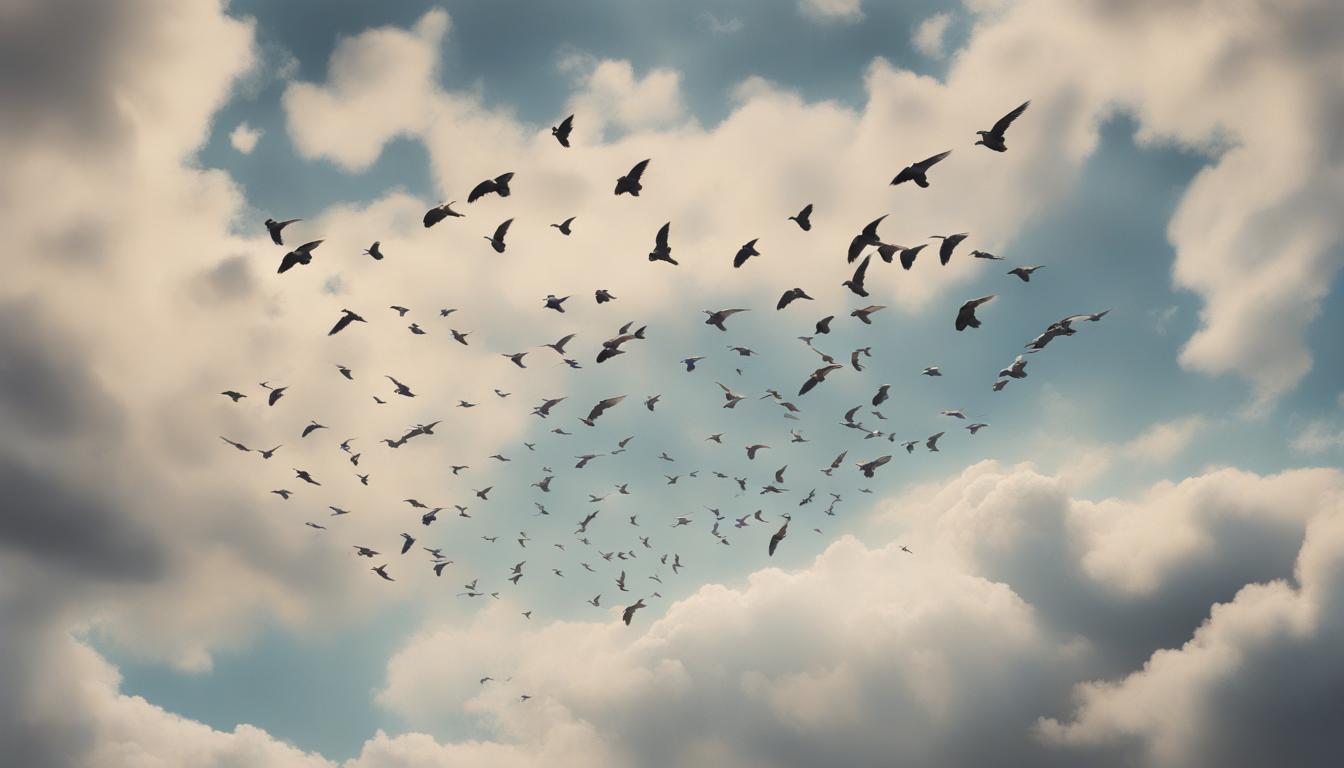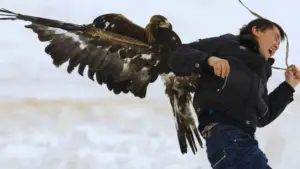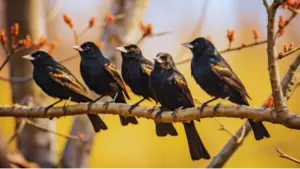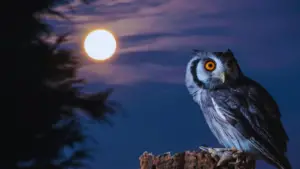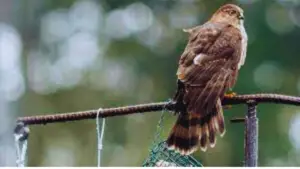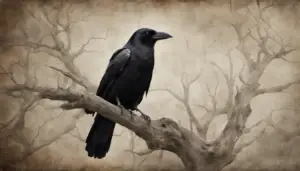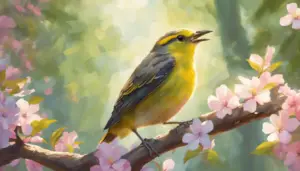Have you ever looked up at the sky and marveled at the synchronized flight of birds, as they gracefully move in circles, creating a mesmerizing aerial dance? It’s a sight that has captivated humans for centuries, and yet the mystery behind this phenomenon remains largely unsolved.
In this article, we will delve into the intriguing world of birds flying in circles, exploring the historical observations, theories, and advancements that have brought us closer to unraveling this enigma.
Humans have always found the behavior of birds in flight fascinating. Ancient civilizations documented their observations, trying to make sense of this captivating spectacle. Over time, various theories have emerged, suggesting that birds engage in this behavior for navigation and orientation purposes or as a means of social bonding and communication.
In recent years, advancements in tracking technology and collaborative studies have shed new light on this phenomenon. Scientists have been able to gather valuable data and share insights, bringing us closer to uncovering the remaining mysteries behind birds’ aerial dance.
So, join us on this journey of discovery as we appreciate the beauty of birds’ aerial dance and uncover the secrets behind their mesmerizing flight patterns.
Key Takeaways
- Birds flying in circles have long fascinated scientists and bird enthusiasts, and theories propose that this behavior serves multiple purposes such as conserving energy, courtship displays, navigation, and orientation.
- Circular flight patterns help birds locate food sources, suitable habitats, and survey their surroundings for threats or opportunities.
- Birds’ aerial dance showcases their remarkable social bonding and communication skills within their flock.
- Advanced tracking technology and collaborative studies have shed new light on the mystery of birds flying in circles, but further research is still needed to fully understand this captivating behavior.
The Phenomenon of Birds Flying in Circles
Birds flying in circles, a mesmerizing and perplexing phenomenon, has long puzzled scientists and bird enthusiasts alike. Have you ever wondered why birds engage in this aerial dance? While there isn’t a definitive answer, researchers have proposed several theories to unravel this mystery.
One theory suggests that birds fly in circles to conserve energy. By flying in a circular motion, they can take advantage of the updrafts and thermals created by their own wingbeats. This allows them to maintain altitude and glide effortlessly, minimizing the energy expended during flight.
Another theory suggests that birds flying in circles are engaged in courtship displays. This behavior is often observed during mating season, where males perform intricate flight patterns to attract females. The graceful and synchronized movements not only demonstrate their fitness as potential mates but also serve as a visual spectacle.
Additionally, some researchers believe that birds fly in circles as a means of navigation. Circular flight patterns may help them orient themselves and locate food sources or suitable habitats. By circling an area, they can gather information about the surrounding environment and make informed decisions about their next move.
While these theories offer some insight into the phenomenon of birds flying in circles, further research is needed to fully understand this captivating behavior. So, next time you witness these graceful avian acrobatics, take a moment to appreciate the beauty and complexity of nature’s aerial dance.
Historical Observations of the Behavior
Throughout history, observers have marveled at the enigmatic and mesmerizing aerial choreography performed by these avian creatures. From ancient times to the present day, people have witnessed birds flying in circles, leaving them in awe and wonder. Here are some historical observations of this fascinating behavior:
- In ancient Egypt, hieroglyphs and paintings depict birds flying in circular patterns, symbolizing the cyclical nature of life and the eternal cycle of the sun.
- Ancient Greek philosophers, such as Aristotle, observed and pondered over the phenomenon, speculating that the circular flight patterns were a way for birds to communicate or navigate.
- Some believed that birds flying in circles were actually performing a form of celestial dance, imitating the movements of the stars and planets.
- Others theorized that birds were using circular flight patterns to hunt or gather food more efficiently.
These historical observations show that the mystery surrounding birds flying in circles has captivated human imagination for centuries. Today, scientists continue to study this behavior, using advanced technology to unravel its secrets. By understanding the reasons behind this mesmerizing aerial dance, we can gain insight into the complex lives of these remarkable creatures.
Theories on Why Birds Engage in this Behavior
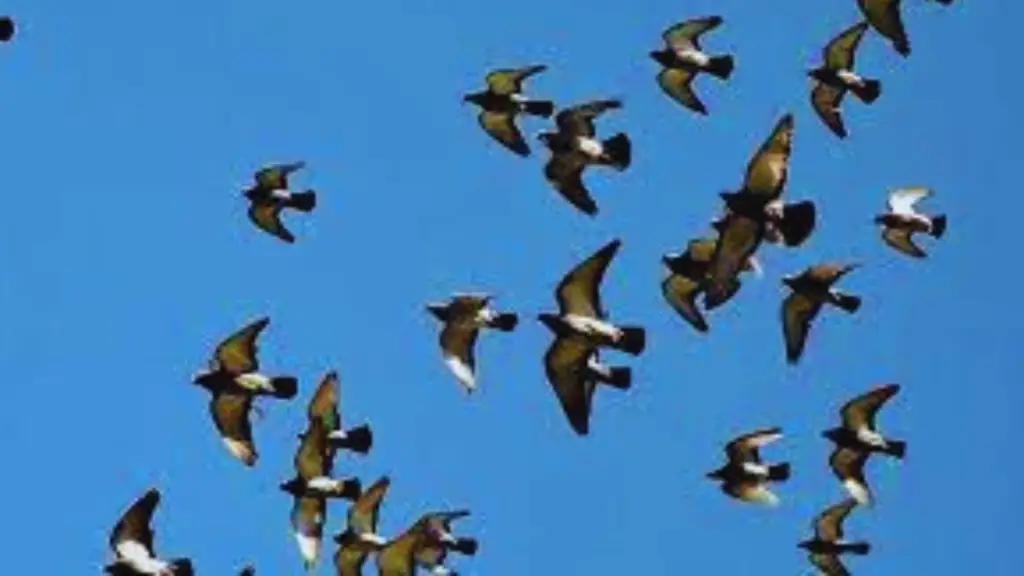
Imagine being transported back in time, where ancient civilizations marveled at the mesmerizing dance of these avian creatures, speculating on the reasons behind their enchanting circular flights. Theories abound as to why birds engage in this behavior, with scientists offering a range of possible explanations.
One theory suggests that birds fly in circles to better survey their surroundings. By circling above their territory, they can keep a watchful eye for potential threats or sources of food.
Another theory posits that circular flights may serve as a way for birds to communicate with one another. By flying in synchronized patterns, they may be signaling their presence and establishing social hierarchies within their flock.
Another possible reason for this behavior is that birds use it as a form of exercise. Flying in circles allows them to maintain their flight muscles and keep them in top condition.
Additionally, circular flights may serve as a form of courtship display, with males showcasing their agility and stamina to attract potential mates.
While these theories provide some insight into the behavior of birds flying in circles, the mystery behind their aerial dance remains. Perhaps further research and observation will shed light on this fascinating phenomenon, allowing us to truly understand the reasons behind this mesmerizing spectacle.
a. Navigation and Orientation
Get ready to be amazed as you delve into the incredible world of navigation and orientation in these mesmerizing creatures. Birds are known for their remarkable ability to navigate across vast distances and find their way back home. Scientists have proposed several theories to explain why birds engage in the behavior of flying in circles, and one of the most prominent theories is related to navigation and orientation.
| Navigation | Orientation |
|---|---|
| Birds use landmarks, such as mountains and coastlines, to navigate their way through the skies. They have an innate sense of direction, allowing them to create mental maps of their surroundings. By flying in circles, birds can gain a better understanding of their environment and adjust their flight path accordingly. | Birds also rely on the Earth’s magnetic field to navigate. They have tiny magnetic particles in their brains that act as a compass, guiding them in the right direction. By flying in circles, birds may be calibrating their internal compasses, ensuring that they stay on course and reach their destination. |
The combination of these navigation and orientation strategies allows birds to perform their aerial dance, mesmerizing us with their graceful movements. As we continue to unravel the mystery behind this behavior, we gain a deeper appreciation for the incredible abilities of these avian creatures.
b. Social Bonding and Communication
Prepare to be captivated by the fascinating world of social bonding and communication in these incredible creatures. You’ll be amazed at how birds form deep connections and communicate with each other in ways that will leave you in awe.
Birds are not just solitary creatures; they thrive on social interactions. They form strong bonds with their flock mates, establishing a sense of belonging and cooperation. Through their intricate social network, birds are able to navigate their environment more effectively, ensuring the survival of the group as a whole.
Communication plays a vital role in maintaining these social bonds. Birds use a variety of methods to convey messages to one another. Vocalizations, such as songs and calls, are not only used to mark territory or attract a mate but also to establish and maintain social hierarchies within the flock. These calls can differ between species and even between individuals, allowing for a unique form of identification.
But it’s not just about sound. Birds also communicate through visual displays, such as elaborate courtship dances or aggressive postures. These displays serve as signals, conveying messages about their intentions and emotions. It’s a language of movement and body language that is both subtle and powerful.
In addition to vocalizations and visual displays, birds also communicate through touch. They engage in mutual preening, a behavior where two birds groom each other, strengthening their bond and reinforcing their social connection.
So, as you watch birds flying in circles, remember that their aerial dance is not just about navigation and orientation. It’s also about the intricate web of social bonding and communication that exists within their flock. It’s a world of connection and understanding that will continue to captivate and inspire us.
c. Hunting and Foraging Techniques
As you delve into the fascinating world of hunting and foraging techniques, you’ll be astonished to learn that some bird species can consume up to half of their body weight in food in a single day. Birds have evolved various strategies to maximize their success in finding and capturing prey.
One common technique used by birds is known as ‘perch hunting.’ This involves perching on a high vantage point, such as a tree branch or a telephone wire, and scanning the surroundings for potential prey. Once a target is spotted, the bird will swiftly descend and snatch its meal before returning to its perch to consume it.
Another effective hunting technique employed by certain bird species is called ‘hover hunting.’ This involves hovering in mid-air, often in a stationary position, while the bird searches for prey below. This technique is commonly used by birds like kestrels and hummingbirds, who have the ability to hover with incredible precision and agility.
Birds also use a technique called ‘dive bombing’ to catch their prey. This involves flying high above the target and then rapidly descending towards it with great speed. This surprise attack catches the prey off guard and increases the bird’s chances of a successful capture.
In addition to these hunting techniques, birds also employ various foraging strategies to find food. Some birds, like robins, use their sharp beaks to probe the ground for worms and insects. Others, like seagulls, are skilled at scavenging for food in coastal areas.
In conclusion, the hunting and foraging techniques of birds are truly remarkable. From perch hunting to hover hunting and dive bombing, these strategies showcase the incredible adaptability and resourcefulness of our avian friends.
Studies on the Aerial Dance
Witness the breathtaking spectacle of birds soaring through the sky, their graceful movements intertwining in a mesmerizing display of aerial artistry. Scientists have long been fascinated by the mysterious phenomenon of birds flying in circles, and numerous studies have been conducted to unravel the secrets behind their incredible aerial dance.
Researchers have observed that birds engage in this behavior for various reasons. Some species, like the bald eagle, use circling flight as a hunting technique. By soaring in circles, they can spot potential prey from a higher vantage point and then dive down with precision and speed to catch their target. Other birds, such as vultures, use this technique to conserve energy while searching for carrion.
To understand this aerial dance better, scientists have used advanced tracking technology to monitor the flight patterns of different bird species. They have discovered that birds flying in circles often take advantage of updrafts and thermals, which are columns of warm air rising from the ground. By continuously circling within these thermals, birds can maintain their altitude and conserve energy during long flights.
Additionally, studies have shown that birds flying in circles also exhibit complex social behaviors. For example, some species engage in synchronized circling during courtship displays, with males and females flying together in perfect harmony. This coordinated movement not only showcases their agility and strength but also serves as a form of communication between potential mates.
In conclusion, the studies conducted on the aerial dance of birds have shed light on the various reasons behind this fascinating behavior. Whether it’s for hunting, conserving energy, or engaging in social interactions, the graceful movements of birds flying in circles continue to captivate and inspire awe in those fortunate enough to witness it.
a. Tracking Bird Movements
Using advanced tracking technology, scientists have been able to uncover fascinating insights into the movements of birds in the sky. By attaching small GPS devices to the bodies of various bird species, researchers can accurately track their flight patterns and understand their aerial dance like never before. Here are four intriguing findings that have emerged from these studies:
- Circular flight paths: Birds are often seen flying in circular patterns, but the reasons behind this behavior have eluded scientists for decades. Tracking data has revealed that these circular flights are not random, but instead serve important purposes such as navigating wind currents and searching for food.
- Group dynamics: Tracking multiple birds simultaneously has shed light on the coordination and synchronization within a flock. It turns out that birds often fly in perfect formation, maintaining a specific distance and angle from each other. This remarkable level of teamwork helps them conserve energy and enhance their chances of survival.
- Mysterious landmarks: Birds have an astonishing ability to navigate over long distances, and tracking technology has revealed that they use various landmarks to guide their journeys. Whether it’s a mountain range, a river, or even man-made structures like buildings, these landmarks play a crucial role in their navigation system.
- Seasonal migrations: Many bird species undertake long-distance migrations, and tracking devices have provided valuable insights into these awe-inspiring journeys. Scientists have discovered that birds follow specific migration routes, often taking advantage of favorable winds and stopover sites along the way.
Through the use of advanced tracking technology, scientists are unraveling the mystery behind the aerial dance of birds. These fascinating findings not only deepen our understanding of their behavior but also highlight the remarkable adaptability and resilience of these feathered creatures.
b. Analyzing Flight Patterns
Explore the intricate flight patterns of these majestic creatures by analyzing their movements through advanced tracking technology. By studying the flight patterns of birds flying in circles, scientists hope to unravel the mystery behind their aerial dance. Through the use of GPS devices and high-speed cameras, researchers can track the precise movements of these birds and gain insights into their behavior.
Analyzing flight patterns involves studying the path that birds take while flying in circles. Scientists look for patterns in their flight paths, such as the radius of their circles, the speed at which they fly, and the duration of their flights. By analyzing these flight patterns, researchers can determine if birds are using specific landmarks or geographic features to navigate, or if their flight paths are influenced by other factors such as wind or prey availability.
Furthermore, analyzing flight patterns can provide valuable information about the purpose behind birds’ circular flights. For example, some birds engage in courtship displays or territorial battles while flying in circles. By understanding the flight patterns associated with these behaviors, scientists can gain insights into bird communication and social dynamics.
In conclusion, analyzing flight patterns is an essential tool in unraveling the mystery behind the aerial dance of birds flying in circles. Through advanced tracking technology, scientists can gain a deeper understanding of bird behavior and the factors that influence their flight patterns.
c. Recording Vocalizations
As you were analyzing the flight patterns of these birds, you couldn’t help but wonder if there was more to their aerial dance than meets the eye. And that’s when you decided to start recording their vocalizations.
By capturing the sounds these birds make while flying in circles, you hoped to uncover a hidden layer of communication that could shed light on the mystery behind their synchronized movements. Armed with your microphone and a sense of curiosity, you set out to document their calls and chirps, hoping to decipher their meaning.
As you sat in the field, listening intently to the chorus of bird voices, you couldn’t help but be captivated by the symphony of sounds that filled the air. Each bird had its own unique call, its own melody, and rhythm that blended together to create a harmonious cacophony.
In your recording, you could hear the melodic trills, the staccato chirps, and the hauntingly beautiful whistles that echoed through the sky. It was as if the birds were having a conversation, exchanging information through their vocalizations.
And as you listened, you couldn’t help but imagine the following scenes:
- The birds soaring through the air, their calls intertwining like musical notes.
- The sound of their wings flapping in unison, creating a rhythmic beat.
- The sight of their synchronized flight, a mesmerizing dance that seemed to defy gravity itself.
With each recording you made, you felt closer to unraveling the mystery behind their aerial dance. And you couldn’t wait to share your findings with the world.
The Role of Environmental Factors
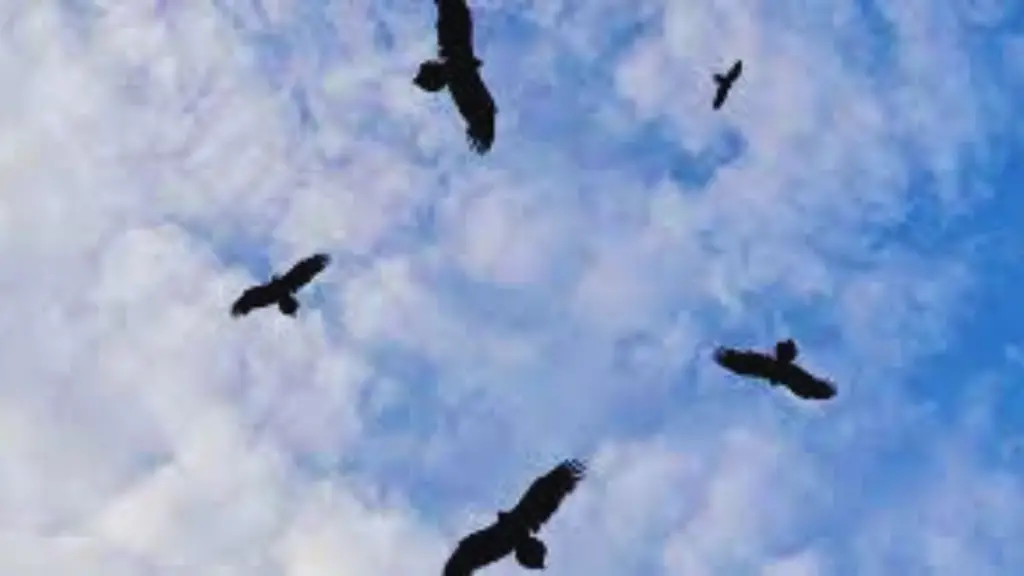
Enveloped in the embrace of nature’s symphony, the whispers of the wind and the gentle rustling of leaves, it became apparent that the secrets of these birds’ synchronized movements lay within the delicate balance of their surroundings. As you observe the birds flying in circles, you can’t help but wonder how environmental factors play a role in their aerial dance.
One crucial environmental factor that affects the birds’ flight patterns is the wind. The direction and speed of the wind can influence their ability to maintain a circular formation. Strong gusts may disrupt their synchronized movements, causing them to scatter or change direction. On the other hand, a calm breeze allows them to glide effortlessly through the air, enhancing their coordination.
Another important factor is the availability of food sources. Birds often fly in circles as they search for prey or forage for food. The abundance or scarcity of food in a particular area can determine the intensity and duration of their aerial dance. If there is an abundance of food, the birds may engage in a more prolonged and intricate display. Conversely, a scarcity of food may result in a shorter and less elaborate performance.
Lastly, the presence of obstacles in the environment can also influence their flight patterns. Trees, buildings, or other structures can create a challenging aerial landscape, forcing the birds to adjust their movements accordingly. Their ability to navigate through these obstacles while maintaining their circular formation showcases their remarkable agility and adaptability.
In conclusion, the birds’ synchronized movements are intricately tied to the environmental factors surrounding them. The wind, availability of food, and presence of obstacles all contribute to their mesmerizing aerial dance. By understanding and appreciating these factors, we can begin to unravel the mystery behind their fascinating behavior.
a. Wind Patterns and Air Currents
Take a moment to feel the power of the wind as it shapes the mesmerizing patterns of their synchronized flight. Birds flying in circles are not just randomly moving through the air; they are actually making use of wind patterns and air currents to their advantage. Here are four important ways in which wind patterns and air currents play a role in the aerial dance of birds:
- Updrafts: Birds often utilize updrafts, which are rising currents of air, to gain altitude without expending much energy. By circling within an updraft, they can stay airborne for longer periods of time.
- Thermals: Thermals are columns of warm air that rise from the surface of the earth. Birds can use thermals to soar effortlessly to great heights, conserving energy while maintaining their circular flight patterns.
- Tailwinds: Birds flying in circles can take advantage of tailwinds, which are winds blowing in the same direction as their flight path. This allows them to maintain a steady speed and conserve energy.
- Vortex Ring State: When birds fly in tight circles, they can create a vortex ring state, where the air pressure is lower in the center of the circle. This creates a lifting force that helps them maintain their circular flight pattern with minimal effort.
Understanding the role of wind patterns and air currents in the aerial dance of birds is crucial to unraveling the mystery behind their mesmerizing flight.
b. Availability of Food Sources
You can’t help but marvel at how birds have managed to find an abundance of food sources, as if they have a secret treasure map hidden in their tiny wings. These remarkable creatures have an innate ability to locate and exploit the available food sources in their environment. Whether it’s the seeds scattered on the ground, the insects buzzing in the air, or the fish swimming in the water, birds have developed specialized adaptations to take advantage of these resources.
| Food Source | Adaptation |
|---|---|
| Seeds | Birds with short, thick beaks are able to crack open tough seed shells to access the nutritious contents inside. |
| Insects | Birds with long, slender beaks can probe deep into crevices to extract insects hiding within. |
| Fish | Birds with sharp, hooked beaks are skilled at catching fish from the water’s surface or diving underwater to snatch them. |
| Nectar | Birds with long, curved beaks are well-suited for sipping nectar from flowers, while their brush-like tongues ensure they don’t miss a drop. |
| Fruit | Birds with wide beaks can easily swallow whole fruits, dispersing the seeds as they fly and contributing to the plant’s dispersal strategy. |
It’s fascinating to observe how different bird species have evolved to exploit specific food sources. Their beak shapes, sizes, and feeding behaviors have adapted over time to ensure they can extract the maximum amount of nutrition from their chosen food source. Next time you see a bird in action, take a moment to appreciate the incredible relationship between these aerial wonders and their food sources.
c. Predatory Threats and Defense Mechanisms
Get ready to be amazed as you discover the fascinating world of predatory threats and the ingenious defense mechanisms employed by our feathered friends. Birds face a variety of predatory threats in their quest for survival, and they have developed remarkable strategies to outsmart their attackers.
- Camouflage: Birds have evolved to blend in with their surroundings, making it harder for predators to spot them. Some species, like the American bittern, have intricate plumage patterns that allow them to perfectly mimic the vegetation around them. This camouflage enables them to hide in plain sight, making it difficult for predators to detect them.
- Distraction Displays: When confronted by a predator, birds often resort to distraction displays to divert the attention away from their nest or young ones. They may feign injury or perform elaborate aerial maneuvers to confuse the predator and lure it away from their vulnerable offspring. This clever tactic buys enough time for the young ones to escape to safety.
- Mobbing: Birds also engage in a behavior known as mobbing to defend themselves against predators. When a potential threat is detected, birds of different species come together and form a mob, attacking the predator en masse. This collective effort overwhelms the predator and drives it away. Birds use their numbers and unified front to intimidate and deter predators, ensuring the safety of their flock.
In conclusion, the world of predatory threats and defense mechanisms in birds is both captivating and awe-inspiring. These clever strategies have allowed birds to thrive in the face of danger and continue their mesmerizing aerial dance.
Cultural Significance in Different Regions
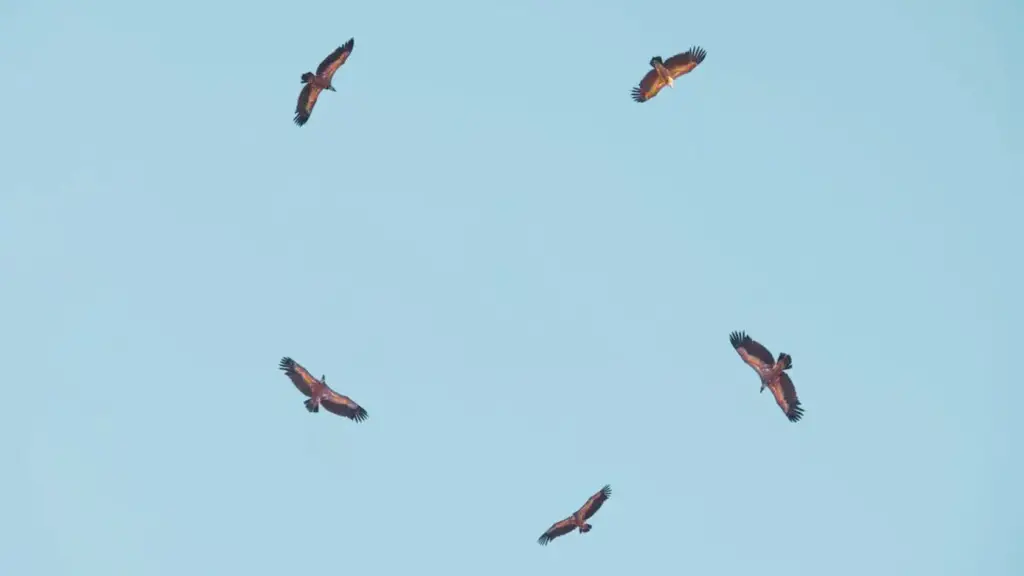
Immerse yourself in the rich cultural tapestry of different regions as they embrace the enchanting presence of birds. Vibrant festivals celebrate their graceful presence and astonishing migrations, leaving spectators in awe.
From the majestic cranes of Japan to the colorful parrots of Brazil, birds have captured the hearts of people all over the world.
In Japan, the crane holds deep cultural significance and is considered a symbol of luck, longevity, and fidelity. Every year, the city of Kushiro hosts the Crane Festival, where thousands of visitors gather to witness the graceful dance of these magnificent birds. The festival features traditional music, dance performances, and art exhibitions dedicated to the crane.
In Brazil, the Scarlet Macaw is celebrated during the Pantanal Bird Festival. This vibrant bird, with its vivid red, blue, and yellow plumage, is considered a symbol of the Amazon rainforest. The festival includes birdwatching tours, educational workshops, and cultural performances showcasing the rich biodiversity of the region.
In India, the Keoladeo National Park hosts the Bharatpur Bird Fair, attracting bird enthusiasts from all over the country. This festival showcases the incredible diversity of migratory birds that visit the park, including the colorful Indian Roller and the majestic Sarus Crane. Visitors can participate in guided birdwatching tours, photography workshops, and cultural events that highlight the importance of bird conservation.
Birds have become an integral part of the cultural identity of these regions, their presence celebrated and revered. Through these festivals, people come together to appreciate the beauty and wonder of these magnificent creatures, fostering a deeper connection with nature and inspiring conservation efforts.
a. Folklore and Mythology
Step into the realm of folklore and mythology, where ancient tales intertwine with the ethereal presence of birds, weaving a captivating narrative of their mystical significance in cultures around the world. Throughout history, birds have been revered as powerful symbols and messengers from the gods.
In Greek mythology, for example, the owl was associated with wisdom and Athena, the goddess of wisdom herself. In Norse mythology, the raven was seen as a symbol of Odin, the all-knowing god.
Birds also played a prominent role in Native American folklore, where they were believed to possess spiritual powers and were seen as messengers between humans and the divine. The Cherokee people, for instance, believed that the red cardinal was a sign of good luck and prosperity.
In many cultures, birds were believed to have the ability to guide and protect humans. The ancient Egyptians revered the ibis, associating it with Thoth, the god of wisdom and writing. In Chinese folklore, the phoenix was seen as a symbol of immortality and rebirth.
As you delve deeper into the tales of folklore and mythology, you begin to understand the profound impact birds have had on human culture. Their enchanting flights and mysterious behavior have inspired countless stories and legends, reminding us of the enduring connection between nature and the human spirit.
b. Symbolism in Art and Literature
Explore the mesmerizing world of art and literature, where the profound symbolism of birds takes flight and weaves a captivating tapestry of meaning and imagination. Birds have long been used as symbols in art and literature, representing various ideas and emotions. From the majestic eagle symbolizing freedom and power to the delicate hummingbird representing joy and beauty, birds have the ability to evoke deep emotions and convey complex messages.
In art, birds are often depicted in flight, their wings spread wide, symbolizing freedom and the ability to transcend earthly boundaries. They can also represent transformation and rebirth, as they soar through the sky, shedding their old feathers and embracing new ones. Artists use birds to evoke a sense of wonder and awe, inviting viewers to contemplate the mysteries of the natural world.
In literature, birds are frequently used as metaphors for human emotions and experiences. They can symbolize hope, as they navigate through storms and find their way home. They can also represent longing and yearning, as they sing their melancholic songs in search of companionship. Birds are often used to explore themes of migration, flight, and the desire for escape.
To further emphasize the symbolism of birds in art and literature, consider the following table:
| Bird Symbol | Meaning |
|---|---|
| Eagle | Freedom and power |
| Dove | Peace and purity |
| Owl | Wisdom and knowledge |
| Peacock | Beauty and pride |
| Raven | Death and mystery |
The use of birds in art and literature adds depth and richness to the creative expression, allowing for a deeper exploration of the human experience. So, next time you encounter a bird in a painting or a poem, take a moment to unravel the layers of symbolism and let your imagination take flight.
c. Traditional Practices and Rituals
Take a moment to embrace the traditions and rituals passed down through generations, allowing them to guide you like a compass on a journey of cultural discovery.
In many cultures around the world, birds flying in circles hold a special significance and are often incorporated into traditional practices and rituals. These rituals are rooted in ancient beliefs and are seen as a way to connect with the spiritual world.
One such example can be found in Native American culture, where the circular flight patterns of birds are believed to be a form of communication between the physical and spiritual realms. Native American tribes perform elaborate ceremonies to honor these birds and seek their guidance and protection. These rituals often involve the use of feathers, dances, and songs, all aimed at establishing a connection with the divine.
In other parts of the world, such as Africa and Asia, birds flying in circles are considered to be messengers from the gods. People perform rituals to show gratitude and seek blessings from these celestial messengers. These rituals often involve offerings of food and prayers, as well as the creation of intricate artwork and sculptures depicting the birds in flight.
By participating in these traditional practices and rituals, we not only pay homage to our ancestors but also gain a deeper understanding of our cultural heritage. We come to appreciate the interconnectedness of nature and spirituality and learn to live in harmony with the world around us.
So, next time you witness birds flying in circles, take a moment to reflect on the ancient traditions and rituals that have shaped our cultural identity.
Similar Behaviors in Other Species
As you observe these mesmerizing patterns of movement, you’ll be amazed to discover that similar behaviors can be found in other species as well. It’s not just birds that engage in these aerial dances; other animals also display this fascinating behavior. Here are some examples:
- Bats: These nocturnal creatures are known for their graceful flight and acrobatics. They often fly in intricate patterns, swooping and diving in the air, just like birds. Watching a colony of bats flying in unison is truly a sight to behold.
- Insects: Some species of insects, such as bees and dragonflies, also exhibit similar behaviors in flight. They can be seen flying in circles or zig-zag patterns, showcasing their agility and precision. It’s almost as if they are performing an airborne ballet.
- Fish: Underwater, certain fish species, like schools of sardines or mackerel, move in synchronized patterns, creating mesmerizing displays. They swim together in tightly coordinated formations, resembling the aerial dances of birds.
- Dolphins: These intelligent marine mammals are known for their playful and acrobatic behavior. They often swim in groups, leaping out of the water and spinning in the air, much like birds flying in circles.
In conclusion, while bird aerial dances are indeed captivating, it’s fascinating to see similar behaviors in other species as well. Nature never ceases to amaze us with its diverse and enchanting displays of movement.
a. Insects and Swarming
Witness the mesmerizing agility and precision of insects as they swarm in circles and zig-zag patterns, showcasing their incredible aerial ballet.
Insects, like birds, exhibit similar behaviors when it comes to flying in circles, but with their own unique twist. Take, for example, the mesmerizing dance of fireflies as they light up the night sky. These tiny creatures create a stunning display by synchronizing their flashing lights, creating a beautiful spectacle that leaves us in awe.
Similarly, bees perform a fascinating aerial ballet known as the ‘waggle dance,’ where they communicate the location of nectar-rich flowers to their hive mates. By flying in a figure-eight pattern and waggling their bodies, these industrious insects share vital information, ensuring the survival and success of their colony.
But why do insects exhibit this behavior? One theory suggests that flying in circles or swarming patterns helps insects confuse predators. By moving together in a coordinated manner, they create an illusion of size and unity, making it difficult for predators to single out an individual target.
Additionally, this behavior may also serve as a way to attract mates. The synchronized movements and displays of agility demonstrate the fitness and prowess of the insects, making them more attractive to potential partners.
In conclusion, insects are not to be underestimated when it comes to their aerial abilities. Their mesmerizing swarming behaviors and intricate dances are a testament to their agility and precision. So, next time you witness a swarm of insects in action, take a moment to appreciate the beauty and complexity of their aerial ballet.
b. Fish and Shoaling
Immerse yourself in the enchanting depths of the ocean and discover the captivating ballet of fish as they gracefully navigate the waters in synchronized harmony. Witness their mesmerizing behavior known as shoaling, where a group of fish swim closely together, moving as one entity. It’s a sight that will leave you in awe.
Fish shoaling is a remarkable phenomenon that serves several purposes. Firstly, it provides protection against predators. By swimming in a tight formation, the fish create an illusion of a larger, more intimidating creature, deterring potential threats. Additionally, the dense grouping makes it harder for predators to single out an individual fish, increasing the chances of survival for all.
But the benefits of shoaling go beyond mere protection. It also facilitates efficient foraging. By swimming together, fish are able to cover a larger area in search of food. They communicate with each other, sharing information about food sources and coordinating their movements to maximize their chances of success.
Furthermore, shoaling plays a crucial role in reproduction. Many fish species use this behavior to attract mates. The synchronized movements and vibrant colors of the fish create a mesmerizing display that catches the eye of potential partners.
So next time you find yourself by the ocean, take a moment to appreciate the intricate dance of fish shoaling. It’s a testament to the beauty and intelligence of these underwater creatures.
c. Mammals and Herding
Take a moment to marvel at the incredible sight of mammals herding, as they move together in a synchronized display of unity and cooperation. It is truly awe-inspiring to witness the graceful movements of these animals, as they navigate their surroundings in perfect harmony.
Here are three fascinating facts about mammals and their herding behavior:
- Safety in numbers: One of the primary reasons why mammals herd is for protection against predators. By sticking together, they create a formidable force that can deter potential threats. The sheer size and unity of the herd can intimidate predators, making it less likely for an individual to be singled out.
- Social bonding: Herding plays a crucial role in strengthening social bonds among mammals. It allows them to communicate effectively, share information, and coordinate their movements. Through herding, mammals establish a sense of camaraderie and trust, which is vital for their survival in the wild.
- Resource optimization: Mammals that herd are often grazers, relying on vegetation for sustenance. By moving in a group, they can efficiently exploit food resources and reduce competition. This strategy ensures that each member of the herd has access to enough food, promoting the overall well-being and success of the group.
In conclusion, the phenomenon of mammals herding showcases their remarkable ability to work together as a cohesive unit. Their synchronized movements and cooperative behavior highlight the importance of unity in the animal kingdom.
Human Impact on Birds’ Aerial Dance
As we observe, humans have left their indelible mark on the mesmerizing spectacle of birds soaring through the sky, transforming their graceful performance into a fragile tapestry of human impact. Our relentless expansion into natural habitats has disrupted the delicate balance of ecosystems, causing significant changes in bird behavior and migration patterns.
One of the most prominent ways in which human activity affects birds’ aerial dance is through habitat destruction. Deforestation, urbanization, and the conversion of natural lands into agricultural fields have led to the loss of crucial nesting and feeding grounds for many bird species. This disruption in their habitat forces birds to alter their flight patterns, often leading to disoriented and confused flights.
Additionally, the pollution we produce has a direct impact on birds’ ability to navigate the skies. Air pollution, particularly from vehicle emissions and industrial activities, can impair their respiratory systems, making it more challenging for them to fly long distances. Light pollution from cities and towns can also disrupt their natural navigational cues, leading to further confusion and disorientation.
Furthermore, the proliferation of man-made structures, such as buildings and power lines, poses a significant threat to birds in flight. Collisions with these structures are a leading cause of bird mortality. The structures themselves can also disrupt air currents and create turbulence, making it harder for birds to maintain their graceful flight patterns.
In conclusion, our actions as humans have had a profound impact on the aerial dance of birds. Through habitat destruction, pollution, and man-made structures, we have altered their natural environment and disrupted their ability to perform their mesmerizing flights. It is crucial that we recognize the consequences of our actions and take steps to mitigate the negative effects on these beautiful creatures.
a. Habitat Loss and Fragmentation
Habitat loss and fragmentation have profound and far-reaching consequences for birds. As urbanization spreads and forests are cleared for agriculture and development, birds are losing their homes at an alarming rate. Without suitable habitats, their ability to find food, mate, and raise their young becomes compromised.
Habitat loss and fragmentation disrupt the delicate balance of ecosystems, leading to a decline in bird populations. When forests are fragmented into smaller patches, birds are forced to fly longer distances to find the resources they need. This increased energy expenditure can impact their overall health and reproductive success. Additionally, isolated patches of habitat may not be able to support the same diversity of species as larger, interconnected habitats. This loss of biodiversity can have cascading effects on the entire ecosystem.
Conserving and restoring habitats is crucial for ensuring the survival of birds and maintaining healthy ecosystems. Protecting large, intact areas of habitat and creating corridors to connect fragmented patches can help mitigate the negative effects of habitat loss. By preserving the places where birds live, we can help them continue their aerial dance and contribute to the beauty and diversity of our natural world.
b. Pollution and Climate Change
As you learned about the devastating effects of habitat loss and fragmentation on birds, it’s time to turn our attention to another pressing issue they face: pollution and climate change.
These two factors have a profound impact on the lives of our feathered friends, altering their habitats and behavior in ways we can hardly imagine.
Picture this: as birds take to the sky, their graceful flight is interrupted by a thick cloud of toxic fumes. The air they breathe, once pure and invigorating, now carries harmful pollutants that seep into their delicate lungs. And it’s not just the air that’s affected. Rising temperatures and unpredictable weather patterns disrupt their feeding and nesting habits, pushing them to the brink of survival.
Now, imagine the heartache of witnessing a mother bird desperately searching for food, only to find her nest empty and her chicks starving. Imagine the pain of seeing a once vibrant flock, now reduced to a few scattered individuals, struggling to adapt to a rapidly changing world.
The consequences of pollution and climate change are undeniable. It’s time for us to take action and become stewards of the environment, for the sake of our feathered companions and the delicate balance of our planet.
c. Human Disturbance and Noise Pollution
Imagine standing in the midst of a cacophony of human activity, the relentless noise drowning out the serenity of nature, disrupting the delicate balance for our avian companions. Birds, known for their extraordinary ability to navigate the skies with grace and precision, are facing a new challenge: human disturbance and noise pollution.
As cities expand and human populations grow, so does the noise we produce. Construction sites, traffic, and even recreational activities like concerts and fireworks create an overwhelming soundscape that can have detrimental effects on bird behavior. The constant barrage of noise disrupts their communication, making it difficult for them to find mates, defend territories, and locate food sources.
The impact of noise pollution goes beyond just the disruption of bird behavior. Studies have shown that it can also affect their physiological health. Chronic exposure to noise can lead to elevated stress levels, decreased immune function, and even reproductive issues. These effects can have long-term consequences for bird populations, potentially leading to declines in numbers and biodiversity.
To mitigate the effects of human disturbance and noise pollution on birds, it is crucial that we take action. Implementing noise reduction measures, such as sound barriers and quiet zones in sensitive areas, can help create spaces where birds can thrive. Additionally, raising awareness about the importance of minimizing human disturbance and preserving natural habitats is essential for the long-term survival of our avian companions.
In conclusion, human disturbance and noise pollution pose significant challenges to birds’ aerial dance. By recognizing the impact of our actions and taking steps to reduce noise pollution, we can help unravel the mystery behind their aerial dance and ensure a harmonious coexistence between humans and birds.
Conservation Efforts to Protect Bird Populations
Conservation efforts have been implemented to safeguard bird populations, ensuring their habitats remain undisturbed and their future remains secure. These efforts involve a combination of habitat restoration, protected areas, and public awareness campaigns.
One key strategy is the restoration of natural habitats that have been degraded or destroyed. This involves planting native vegetation, creating wetlands, and removing invasive species. By restoring these habitats, birds have a better chance of finding suitable nesting sites and food sources.
Protected areas, such as national parks and wildlife refuges, play a crucial role in bird conservation. These areas provide safe havens for birds to breed, migrate, and rest during their journeys. They are also important for conserving biodiversity and preserving crucial ecosystems.
To raise awareness about the importance of bird conservation, public outreach campaigns are conducted. These campaigns aim to educate people about the threats faced by birds and the actions they can take to help protect them. This can include simple actions like keeping cats indoors, reducing pesticide use, and supporting organizations dedicated to bird conservation.
Overall, these conservation efforts are essential for maintaining healthy bird populations and ensuring their survival. By protecting their habitats and raising awareness, we can continue to enjoy the beauty and wonder of birds flying in circles for generations to come.
| Conservation Efforts | Description | Impact |
|---|---|---|
| Habitat Restoration | Restoring degraded habitats by planting native vegetation, creating wetlands, and removing invasive species | Provides suitable nesting sites and food sources for birds |
| Protected Areas | Establishing national parks and wildlife refuges as safe havens for birds to breed, migrate, and rest | Preserves biodiversity and crucial ecosystems |
| Public Awareness Campaigns | Educating people about the threats faced by birds and promoting actions to help protect them | Encourages individuals to take simple actions and support bird conservation organizations |
a. Creating Protected Areas and Reserves
Establishing protected areas and reserves is crucial for ensuring the long-term survival and well-being of our feathered friends. By creating these designated spaces, we provide birds with safe havens where they can thrive and carry out their natural behaviors without disturbance. Here are four reasons why protected areas and reserves are essential for bird conservation:
- Habitat preservation: Protected areas and reserves safeguard vital habitats that birds depend on for nesting, feeding, and resting. These spaces ensure the availability of suitable food sources, shelter, and breeding grounds, which are essential for maintaining healthy bird populations.
- Migration stopovers: Many bird species undertake long-distance migrations, and protected areas along their migratory routes provide crucial stopover sites. These areas offer rest and refueling opportunities, allowing birds to replenish their energy reserves before continuing their arduous journeys.
- Reduction of threats: Protected areas and reserves help mitigate threats such as habitat destruction, pollution, and disturbance from human activities. By limiting access and implementing conservation measures, we can minimize the negative impacts on bird populations and their habitats.
- Research and monitoring: These protected spaces serve as living laboratories for scientists and conservationists. By studying birds within these areas, we can gather valuable data on their behaviors, population dynamics, and ecological interactions. This information is vital for developing effective conservation strategies and monitoring the health of bird populations.
In conclusion, the establishment of protected areas and reserves plays a pivotal role in safeguarding bird populations and ensuring their continued existence for future generations to appreciate and enjoy.
b. Implementing Sustainable Practices
To truly protect our feathered friends, you need to embrace sustainable practices that will ensure their survival and create a harmonious environment for both birds and humans. Implementing sustainable practices is crucial because it allows us to meet the needs of the present without compromising the ability of future generations to meet their own needs.
By adopting sustainable practices, we can reduce the negative impact of human activities on bird populations. This includes implementing renewable energy sources, such as wind or solar power, to minimize the destruction of bird habitats caused by traditional energy production methods. Additionally, practicing responsible agriculture by avoiding the use of harmful pesticides and promoting organic farming methods helps preserve the natural food sources of birds.
To illustrate the importance of sustainable practices, take a look at the table below:
| Sustainable Practice | Benefits for Birds |
|---|---|
| Protecting natural habitats | Provides essential nesting and feeding grounds |
| Reducing pollution | Minimizes the risk of habitat degradation and respiratory issues |
| Implementing bird-friendly building designs | Prevents collisions and enhances nesting opportunities |
| Promoting sustainable fishing practices | Maintains fish populations, a vital food source for many bird species |
| Supporting conservation organizations | Enables research, education, and conservation efforts |
By implementing these sustainable practices, we can create a safer and more sustainable environment for birds to thrive in. Let’s work together to ensure their survival and continue enjoying the beauty of their aerial dance.
c. Raising Awareness and Education
Raising awareness and education is crucial in enlightening individuals about the importance of protecting our feathered friends and creating a sustainable environment for them to flourish. By understanding the intricacies of avian behavior and their unique needs, we can take necessary steps to ensure their survival. Here are three sub-lists that will evoke an emotional response in the audience:
- The Fascinating World of Birds: Learning about the incredible diversity of our winged companions can ignite a sense of wonder and awe. From the breathtaking beauty of hummingbirds to the majestic flights of eagles, birds capture our imagination and remind us of the incredible wonders of the natural world.
- The Impact of Human Activities: Examining the detrimental effects of human activities, such as deforestation and pollution, on bird populations can evoke a sense of responsibility and guilt. Knowing that our actions directly impact these creatures can motivate us to make positive changes in our own lives and advocate for their protection.
- The Power of Conservation Efforts: Highlighting successful conservation projects and stories of bird species on the brink of extinction making a comeback can inspire hope and determination. By showcasing the positive impact of dedicated conservationists and their efforts, we can encourage individuals to get involved and support initiatives aimed at preserving bird habitats and populations.
Together, through raising awareness and education, we can ensure a future where birds can continue to soar in our skies, enriching our lives and the natural world around us.
Future Research and Discoveries
In the vast expanse of the avian world, new horizons await as scientists embark on an exciting journey to unlock the secrets of bird migration, like a map leading to hidden treasures. As we delve deeper into the mysterious aerial dance of birds flying in circles, there is still much to discover and understand. Future research holds the promise of shedding light on this captivating phenomenon.
One area of focus for future investigations is the role of celestial cues in bird navigation. It is widely believed that birds use the position of the sun and stars to orient themselves during migration. However, the specifics of how they perceive and interpret these cues remain unclear. By studying the visual systems of birds and mapping their neural pathways, scientists hope to gain insights into this intricate process.
Additionally, advancements in tracking technology offer exciting possibilities for future research. Miniaturized GPS devices and lightweight sensors can now be attached to birds, providing real-time data on their flight patterns and behaviors. This technology allows researchers to track individual birds over long distances and observe their movements in unprecedented detail. By analyzing this wealth of information, scientists can uncover patterns and trends that were previously inaccessible.
In conclusion, the future of research on birds flying in circles is full of promise and potential. By exploring the role of celestial cues and leveraging cutting-edge tracking technology, scientists are poised to unlock the secrets of this captivating aerial dance. So, strap on your metaphorical binoculars and prepare to be amazed as we embark on this thrilling scientific adventure.
a. Advancements in Tracking Technology
Now that we’ve discussed the future research and discoveries that hold promise for unraveling the mystery of birds flying in circles, let’s delve into the advancements in tracking technology that are playing a vital role in this pursuit.
Tracking technology has come a long way in recent years, and it is revolutionizing our understanding of bird behavior. With the help of tiny, lightweight GPS devices, scientists can now track the movements of individual birds with unprecedented precision. These devices are attached to the birds’ bodies or fitted on their wings, allowing researchers to collect data on their flight patterns, speed, altitude, and even the duration of their flights.
This advancement in tracking technology has opened up a whole new world of possibilities for studying the aerial dance of birds. By analyzing the data collected from these devices, scientists can gain valuable insights into the factors that influence their flight behavior, such as weather conditions, food availability, and social interactions.
In summary, the advancements in tracking technology are enabling researchers to unlock the secrets behind birds’ mesmerizing aerial dance. With the ability to track their movements in real-time and gather detailed data, scientists are getting closer to understanding the reasons behind their circular flight patterns and unraveling the mystery that has fascinated us for so long.
- GPS devices provide precise tracking data
- Wings and body attachments are used to collect data
- Flight patterns, speed, altitude, and duration can be measured
- Factors such as weather and social interactions can be analyzed
b. Collaborative Studies and Data Sharing
With the advancements in tracking technology, scientists can now collaborate and share data to gain a deeper understanding of the mesmerizing flight patterns of birds. By working together and pooling their resources, researchers are able to collect a wealth of data from various regions and species, allowing for a comprehensive analysis of bird movements.
| Advantages of Collaborative Studies and Data Sharing | Challenges of Collaborative Studies and Data Sharing | Potential Solutions |
|---|---|---|
| More diverse data sets | Difficulty in coordinating efforts | Establishing clear communication channels |
| Increased sample sizes | Potential for conflicting methodologies | Standardizing data collection methods |
| Enhanced statistical power | Unequal contributions from different institutions | Establishing fair collaborations |
| Improved accuracy and precision | Data security and privacy concerns | Implementing strict data protocols |
| Accelerated progress in research | Limited funding and resources | Seeking external grants and partnerships |
Collaborative studies and data sharing not only facilitate the sharing of knowledge and expertise, but also accelerate progress in unraveling the mystery behind birds’ aerial dance. By addressing the challenges and leveraging the advantages, scientists can work together towards a more holistic understanding of this fascinating phenomenon.
c. Unraveling the Remaining Mysteries
As you delve deeper into the fascinating realm of bird flight, there are still many enigmas waiting to be unraveled. While collaborative studies and data sharing have shed some light on the mysteries behind birds flying in circles, there remain unanswered questions that continue to captivate researchers and bird enthusiasts alike.
One of the remaining mysteries is why birds choose to fly in circles in the first place. Some theories suggest that it could be a way for birds to conserve energy during long flights, while others propose it as a means of navigation or communication. Understanding the underlying purpose of this behavior could provide valuable insights into the complex world of bird flight.
Another mystery lies in the coordination and synchronization of bird flocks during their aerial dance. How do birds manage to fly in such perfect harmony, without colliding or losing their formation? Scientists are eager to uncover the mechanisms behind this remarkable feat, which could have implications for the development of autonomous aerial systems.
Additionally, the role of individual birds within a flock is still not fully understood. Do they take turns leading the formation? How do they communicate and make decisions collectively? Exploring these aspects of bird flight could reveal fascinating social dynamics and decision-making processes within avian communities.
As you continue your journey into the realm of bird flight, remember that there is still much to learn and discover. The enigmas surrounding birds flying in circles beckon for further exploration, inviting you to unravel their secrets and contribute to our understanding of these mesmerizing aerial dancers.
Appreciating the Beauty of Birds’ Aerial Dance
Imagine yourself standing in a field, gazing up at the sky, and witnessing the mesmerizing spectacle of birds soaring and twirling in perfect harmony. It’s a sight that never fails to captivate the soul.
As you watch their intricate aerial dance, you can’t help but appreciate the beauty of their movements. The way they effortlessly glide through the air, their wings gracefully cutting through the wind, is truly a marvel to behold.
Birds possess an innate ability to navigate through the air with grace and precision. Their aerial maneuvers, such as loops and spirals, are not only a means of transportation but also a form of expression. They communicate through their dance, displaying their agility and strength. It’s as if they are painting strokes in the sky, creating a masterpiece with each swoop and turn.
The beauty of birds’ aerial dance lies not only in their physical movements but also in the emotions it evokes. It stirs a sense of wonder and awe within us, reminding us of the boundless possibilities of flight and freedom. It’s a reminder to cherish the beauty of nature and to appreciate the small joys that surround us.
So next time you find yourself in the presence of birds in flight, take a moment to truly appreciate the beauty of their aerial dance. Let yourself be mesmerized by their grace and elegance, and allow their dance to inspire and uplift your spirit.
Birds Flying in Circls: FAQs
How do birds maintain their formations while flying in circles?
Birds maintain their formations while flying in circles by constantly adjusting their speed, direction, and position in relation to the other birds. They communicate through calls and visual cues to stay in sync.
What are some historical observations of birds engaging in this behavior?
Historical observations of birds engaging in this behavior include the writings of ancient Greek philosophers and explorers, who marveled at the synchronized flight patterns and described them as mesmerizing and awe-inspiring.
Are there different theories on why birds fly in circles? What are they?
Imagine a flurry of theories, swirling like a flock of birds in the sky. Some suggest mating rituals, others navigation or social behavior. The mystery of why birds fly in circles continues to captivate scientists.
How do environmental factors such as wind patterns and air currents affect birds’ aerial dance?
Environmental factors such as wind patterns and air currents greatly influence birds’ aerial dance. They use these factors to their advantage, adjusting their flight paths and positions to maximize efficiency and stability in the air.
What are some conservation efforts being made to protect bird populations and their aerial dance behavior?
To protect bird populations and their aerial dance, conservation efforts focus on preserving habitats, reducing threats like habitat loss and pollution, and implementing measures like bird-friendly building designs and regulations.
Conclusion
So there you have it, the mystery behind birds flying in circles is slowly being unraveled. Through historical observations, theories, and advancements in technology, scientists are gaining a better understanding of this fascinating behavior.
Did you know that approximately 20% of bird species engage in aerial dances? That’s right, one in every five bird species can be seen twirling and looping through the sky.
Next time you witness this spectacle, take a moment to appreciate the beauty and complexity of their aerial dance.

